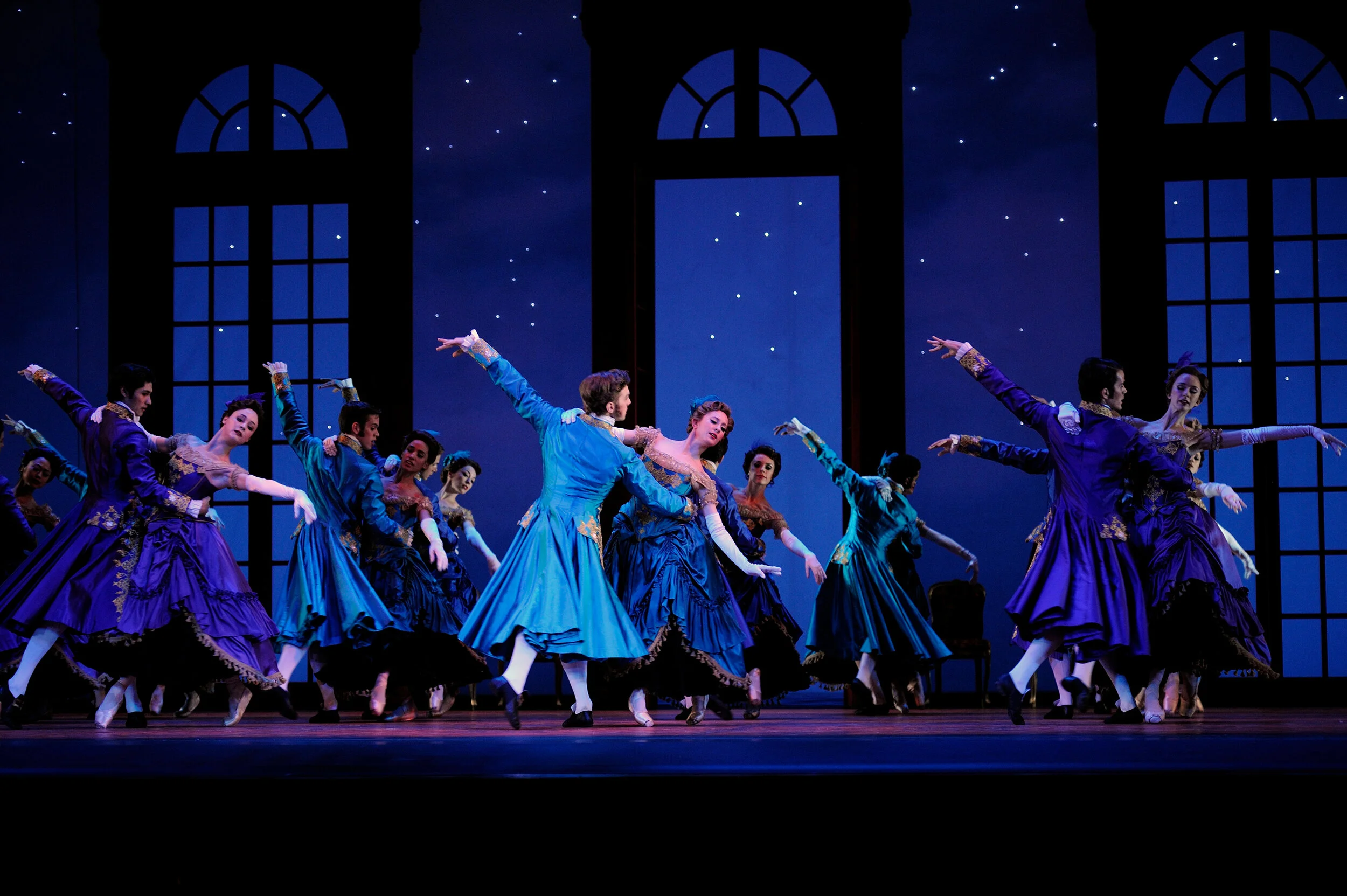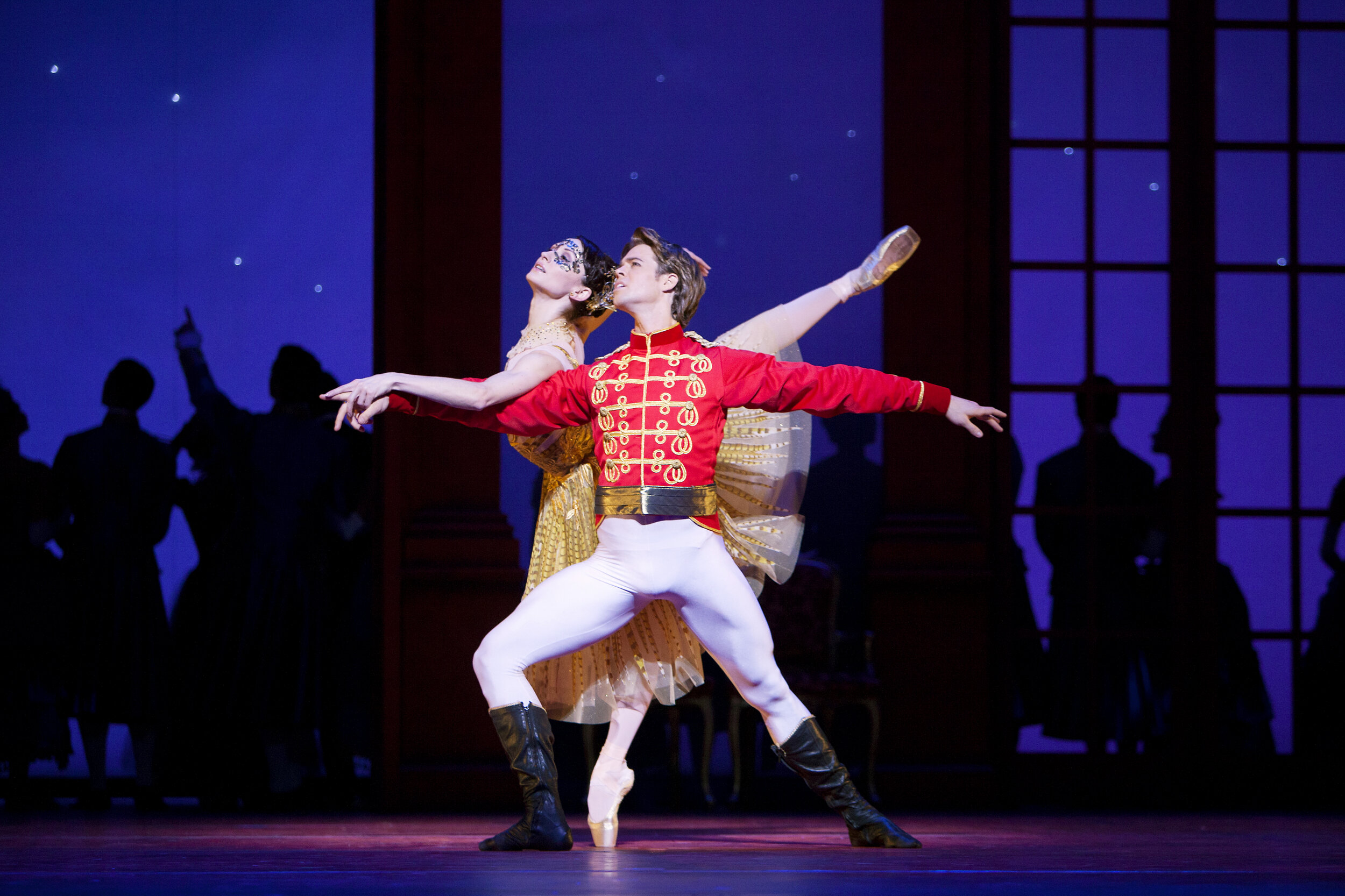
Cinderella
Photo © Erik Tomasson
"A triumph of storytelling and stage design firmly in touch with the 21st Century."
-Laura Cappelle... Financial Times
"Cinderella is a freshly conceived thoroughly enjoyable slice of popular entertainment that is playful and romantically transporting".
-David Dougill... The Sunday Times
"Breathtaking."
-The New York Times
"Wheeldon's ballroom scene is a whirl of rhythm and colour."
-Zoe Anderson... The Independent
The Story
Young Cinderella is playing outside with her mother and father when suddenly her mother becomes ill. In terrifying rapidity, her mother is taken from her and Four Fates are left to watch over Cinderella, who weeps over her mother’s grave. A tree sprouts from her tears. The young Prince Guillaume and his friend Benjamin (the valet’s son) are pursued by Madame Mansard (the prince’s dancing mistress). They dash through the hallways of the palace, causing havoc. Suddenly King Albert and Queen Charlotte appear, stiff and formal. The king is appalled at Guillaume’s lack of discipline, but the queen is more forgiving. The boys dash off again into the garden. Cinderella, now older, brings flowers to her mother’s grave. Two girls, Clementine and Edwina, appear, followed by their mother Hortensia, on the arm of Cinderella’s father. Cinderella realizes that this is to be her new family. Hortensia hands Clementine a bouquet to present to Cinderella who, horrified on behalf of her dead mother, discards it. Her father insists that she take the flowers, but Cinderella hurls them at Hortensia’s feet. Cinderella’s father will not tolerate this behavior. Fueled by devotion for her father, Cinderella assumes a subservient attitude towards the women, thus sealing her own fate. King Albert attempts to explain to his grown son the political connections to be gained by marrying a titled princess. Queen Charlotte writes invitations to an upcoming ball, where the prince will meet these prospective brides. Guillaume is distracted by Benjamin, who imitates the many foreign princesses in the portraits hanging on the walls. King Albert becomes enraged at his son’s lack of responsibility to his future kingdom, but Guillaume cannot believe his parents would force him into a loveless marriage. Albert insists the invitations be delivered in person by the prince himself. Guillaume and Benjamin hatch a plan to trade places, pretending to be one another. Cinderella stoically serves her family breakfast. The briefest sign of tenderness towards Cinderella from her father is frowned upon by Hortensia. Edwina follows closely in her mother’s footsteps, gaining favors from her. Clementine, the sweeter stepsister, is bullied into following suit. A poor beggar arrives at the door seeking food and warmth. Taking pity, Cinderella brings him into the kitchen, but Hortensia, horrified, casts him out again. “The Prince” (Benjamin) appears at the door. He has discovered the poor beggar outside and insists that Hortensia provide him with food and warmth. Hortensia feigns concern and orders Cinderella to help the beggar. “The Prince” has come to deliver invitations to a ball where he shall choose his bride. Left alone with Cinderella, the beggar (Prince Guillaume in disguise) sees true kindness in this girl. The two pretend to be at the ball, laughing and dancing. Cinderella is cleaning the kitchen when the rest of her family appears, dressed for the ball. There is an invitation for Cinderella, but Hortensia throws it into the fire, and her family departs for the palace without Cinderella. The Fates, who have continued to watch over Cinderella, present her with her invitation and lead her to her mother’s grave. From the tree, spirits of Lightness, Fluidity, Generosity, and Mystery appear to teach Cinderella the steps she will need for the ball. Embraced by the branches, Cinderella is transformed, and the Fates send her on her way to the ball—cryptically warning her to keep an eye on the time. The ball is underway when Cinderella’s family arrives. The king and queen witness the rather tipsy arrival of Prince Guillaume and Benjamin, neither in correct attire for such a formal occasion. Cinderella’s stepsisters still believe Benjamin to be the prince, giving the two young men another chance for deception. Guillaume finds he is uninterested in any of the eligible ladies, stepsisters included. A magical atmosphere fills the ballroom as a mysterious masked girl arrives. Guillaume is immediately drawn to her. Cinderella, recognizing Guillaume as the urchin, turns to flee, but is gently guided back to him by the Fates. The couple waltz together. Seeing the interest the prince shows in this mysterious beauty, Hortensia takes to the bottle, humiliating herself. Benjamin dances with Clementine, whom he likes. Guillaume and Cinderella dance, falling deeper in love. When Hortensia rips off Cinderella’s mask, it is time for her to flee. In the chaos caused by her sudden departure, she leaves behind one golden shoe. Guillaume vows to marry her. Benjamin and Guillaume search for Cinderella, trying the shoe on every female foot they can find. Cinderella awakens, and with the help of the Fates, remembers her astonishing night at the palace. Hiding the other golden shoe on the mantelpiece, she resigns herself to her daily chores. Clementine tells Cinderella of the boy she met, and then Edwina turns suspicious when she spies Cinderella dancing steps from the ball. Hortensia viciously attacks Cinderella, and her father must step in. Unannounced, Benjamin and Guillaume arrive, exhausted from trying the shoe on so many feet. When the shoe does not fit either of the stepsisters, Hortensia throws it into the fire. Cinderella comes forward with the matching shoe: Prince Guillaume has found his princess. Cinderella and her prince leave the family behind. All is not lost for Clementine, however, as Benjamin returns to take her with him. And a royal wedding is held.
PROGRAM NOTES by Cheryl A. Ossola
The heart of the old, the spirit of the new. Christopher Wheeldon’s Cinderella tells the same uplifting story people have heard for centuries, but is a ballet full of innovations and modern twists. A co-production of San Francisco Ballet and Dutch National Ballet, Cinderella premiered in Amsterdam in 2012, then made its US premiere in San Francisco in 2013.
“Each of Christopher’s works has something unique,” says Helgi Tomasson, SF Ballet’s artistic director and principal choreographer. Wheeldon is an acclaimed dancemaker, in demand at companies worldwide. Formerly a resident choreographer at New York City Ballet and now an artistic associate at The Royal Ballet, he caused a sensation on Broadway with the musical An American in Paris. And he’s a frequent presence at SF Ballet, with 13 works in the repertory. Cinderella was his eighth commission and first full-length story ballet for the Company.
Tomasson’s words about originality ring true in Wheeldon’s Cinderella. You’ll find no fairy godmother, no pumpkin coach, no clock striking midnight—but you won’t miss them a bit when a tree comes alive and “dances,” or when Cinderella shows backbone and her Prince’s charm runs deep. And you won’t miss them when the dancing and the storytelling come from Christopher Wheeldon. “What I wanted to do,” the choreographer says, “was echo the darkness in the music by taking some of the themes from the Brothers Grimm version rather than the [Charles] Perrault version,” with its fairy godmother and pumpkin coach. “The Grimm version is more serious and a bit darker, centered around nature and the spirit of mother.” That’s where he got the idea of a tree that grows from the grave of Cinderella’s mother, “the deliverer of all things magic, which I think is more poetic [than a fairy godmother] and quite beautiful,” he says. “There are comic moments because there’s comedy written into the music, but it’s a more serious Cinderella in a way.”











Photos courtesy of Het Nationale (Angela Sterling), San Francisco Ballet (Erik Tomasson)
Creative Team
Choreographer
Christopher Wheeldon
Composer
Sergei Prokofiev
Assistant to the Choreographer
Jacquelin Barrett
Libretto
Craig Lucas
Scenic and Costume Design
Julian Crouch
Lighting Design
Natasha Katz
Tree and Carriage Sequence Direction/Design
Basil Twist
Projection Design
Daniel Brodie
Scenic Associate
Frank McCullough
World Premiere: December 13, 2012—Dutch National Ballet, Het Muziektheater; Amsterdam, Netherlands
U.S. Premiere: May 3, 2013—San Francisco Ballet, War Memorial Opera House; San Francisco, California
Cinderella is a co-production of San Francisco Ballet and Dutch National Ballet.
Cinderella is currently in the repertoire at:
English National Ballet, United Kingdom, London
Dutch National Ballet, Netherlands, Amsterdam
San Francisco Ballet, USA, San Francisco
Bayerisches Staatsballett, Germany, Munich